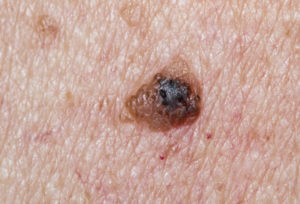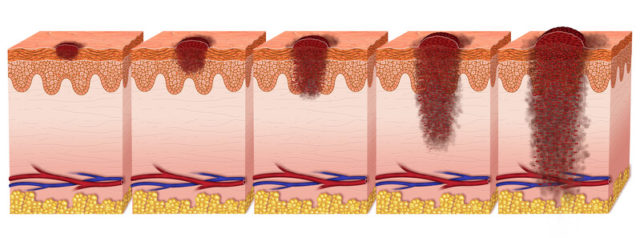 Melanoma is the deadliest form of skin cancer and it affects almost 100,000 Americans every year. A melanoma patient’s chances of survival and potential recovery depend almost completely on how early the cancer is diagnosed. When doctors discover it, they look at cells throughout the body to see how far the cancer has spread. This process is called staging. Here’s what you need to know about each stage of melanoma.
Melanoma is the deadliest form of skin cancer and it affects almost 100,000 Americans every year. A melanoma patient’s chances of survival and potential recovery depend almost completely on how early the cancer is diagnosed. When doctors discover it, they look at cells throughout the body to see how far the cancer has spread. This process is called staging. Here’s what you need to know about each stage of melanoma.
Stage 0 – Melanoma in situ
This is the earliest stage of melanoma. “In situ” is latin for “in position.” This means that the cancer has only gone into the top layer of skin and nowhere else. When caught at this stage, melanoma has a five year survival rate of 97%. Typical treatment for Stage 0 is a surgery during which the affected skin cells are literally cut off. Some cells around the cancer will be cut off also so the doctors can make sure the melanoma has not begun to spread. The American Cancer Society says some doctors choose radiation therapy at this stage, but the removal surgery is most commonly used.
Stage 1 melanoma
This stage occurs when the cancer has penetrated the top layer of skin. This means the cancer has not reached lymph nodes or organs, so it can still be removed through the surgery, according to Dr. Noelani Gonzalez at Mount Sinai Icahn School of Medicine.
Stage 2 melanoma
In this stage, the melanoma will be larger than in stage 1 and will have penetrated deeper into the skin through a process called ulceration. However, the cancer at this stage has still not spread to any lymph nodes or organs. The melanoma is localized, meaning it has not spread at this stage. The removal surgery is the most common treatment.
Stage 3 melanoma
In stage 3, the cancer has spread to nearby lymph nodes but not organs that are further away. They are broken into smaller “sub-stages” depending on how big they are and how many lymph nodes are affected. These cancers have a 64% survival rate over five years, even though they have not spread to distant sites in the body. Because the tumor in this stage is larger, doctors will often have to remove much more than just the original tumor. They will also have to send some of the removed tissue for testing. More treatment may be necessary to prevent the cancer from coming back.
Stage 4 melanoma
In this stage, the cancer has spread to the body’s major organs. Melanoma in this stage is called metastatic. The five0year survival rate at this stage is just 23%. It is extremely difficult to cure. Doctors will try to cut out the original tumor and attempt to shrink the rest with radiation therapy. This is because other organs often cannot be treated with surgery. Sometimes certain drugs can be used to help with the cancer symptoms, but these drugs do not increase survival rate.
Protecting Yourself From Melanoma
 Most melanoma patients make a full recovery because the disease is often found in one of the first three stages, according to Dr. Gonzalez. However, this isn’t always the case because some people ignore the signs and symptoms. Dr. Gonzalez says you should always report any skin changes to your doctor immediately. Melanoma is an aggressive cancer, and it spreads quickly. Risk factors for melanoma include sunlight exposure and having light skin or light hair. It can also be hereditary. Gonzalez says your regular skin exams can save your life.
Most melanoma patients make a full recovery because the disease is often found in one of the first three stages, according to Dr. Gonzalez. However, this isn’t always the case because some people ignore the signs and symptoms. Dr. Gonzalez says you should always report any skin changes to your doctor immediately. Melanoma is an aggressive cancer, and it spreads quickly. Risk factors for melanoma include sunlight exposure and having light skin or light hair. It can also be hereditary. Gonzalez says your regular skin exams can save your life.




























